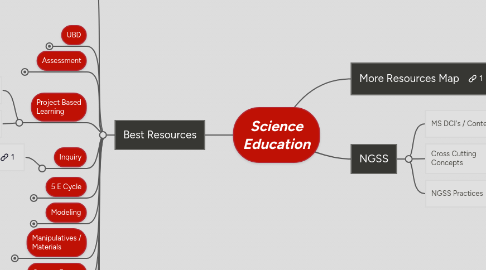
1. Best Resources
1.1. General
1.1.1. Edutopia: PBL
1.1.2. CIESE
1.1.3. NGSS
1.1.3.1. NGSS@NSTA
1.1.3.2. Cross Cutting Concepts
1.1.3.3. Science and Engineering Practices
1.2. UBD
1.2.1. Jay McTighe
1.2.2. Mass. Model Curriculum
1.3. Assessment
1.3.1. Mini-Posters
1.3.2. Performance Assessments
1.3.3. Tom Guskey
1.3.3.1. Mastery Learning
1.3.3.2. Exemplary
1.3.3.3. Whether a lesson works depends on whether students are able to do what you are teaching
1.3.3.4. Every kid should have one successful learning experience in 6 hours
1.3.3.5. Implications
1.3.3.5.1. 1: Assessments must be sources of information for students and teachers
1.3.3.5.2. 2: Assessments must be followed by high quality corrective instruction
1.3.3.5.3. 3: Students must be given a second chance to show improvement
1.3.3.5.4. 4:
1.3.3.6. Re-Take
1.3.3.6.1. Re-Take 3-4 sentence summary of concept
1.3.3.6.2. Correctives done in class to start - transition to at home
1.3.3.6.3. lesson - lesson - lesson - formative - corrective (no review) - small group enrichments (outside of curriculum, rewarding)
1.3.3.7. Spiralling assessment questions
1.3.3.7.1. Practices
1.3.3.7.2. CCC
1.3.3.8. Learning Sequence
1.3.3.8.1. Unit 1
1.3.3.9. Grading
1.3.3.9.1. Variance
1.4. Project Based Learning
1.4.1. Elements of PBL
1.4.2. PBL Design Rubric
1.5. Inquiry
1.5.1. Inquiry Lab Form
1.6. 5 E Cycle
1.6.1. Engage
1.6.1.1. Elicit
1.6.1.2. Hook
1.6.1.3. Question
1.6.2. Explore
1.6.2.1. Asking Questions
1.6.2.2. Conduct Investigations, Test Predictions
1.6.2.3. Data Analysis
1.6.2.4. Model
1.6.3. Explain
1.6.3.1. Videos, Presentations, Readings, Problems
1.6.3.2. Constructing Explanations/Designing Solutions
1.6.3.3. Arguing From Evidence
1.6.3.4. Communicating Information
1.6.3.5. Model
1.6.3.6. Peers, Teacher, Reflection
1.6.4. Extend
1.6.4.1. Elaborate
1.6.4.2. Reflection
1.6.4.3. Connections, Apply, Transfer
1.6.5. Evaluate
1.6.5.1. student questioning
1.6.5.2. summary quiz
1.6.5.3. rubrics
1.6.5.4. observations, interviews
1.6.5.5. portfolio reflections
1.6.5.6. products
1.7. Modeling
1.7.1. AMTA
1.8. Manipulatives / Materials
1.8.1. IV, DV Dice
1.9. Current Events
1.9.1. Newsela
1.10. Simulations
1.10.1. Concord Consortium
1.10.2. PhET
1.11. MYP Structure
1.12. People
1.12.1. Paul Anderson
1.13. Model Schools
1.13.1. Big Picture
1.13.2. High Tech High
1.14. Classroom of the Future
1.14.1. Global Digital Citizens
2. More Resources Map
3. NGSS
3.1. MS DCI's / Content
3.1.1. Progression
3.1.2. Life
3.1.3. Physical Sciences
3.1.4. Earth Space Sciences
3.1.5. Engineering Technology
3.1.6. Evidence Statements
3.2. Cross Cutting Concepts
3.2.1. Patterns
3.2.2. Cause Effect
3.2.3. Scale Proportion Quantity
3.2.4. Systems / System Models
3.2.5. Energy Matter
3.2.6. Structure Function
3.2.7. Stability Change
3.3. NGSS Practices
3.3.1. Asking Questions / Defining Problems
3.3.1.1. Paul Anderson Video Explanation
3.3.2. Using Models
3.3.2.1. Paul Anderson Video Explanation
3.3.2.2. 1-2 per unit
3.3.2.3. Sequence
3.3.2.3.1. Discrepant Events, Misconceptions
3.3.2.3.2. Individual Model
3.3.2.3.3. Group of 3 Share
3.3.2.3.4. Each group presents
3.3.2.4. Resources
3.3.2.4.1. American Modeling Teachers Association
3.3.2.4.2. Nature of Scientific Thinking-Harvard
3.3.3. Conducting Investigations
3.3.3.1. Inquiry Lab Form
3.3.3.2. IV, DV Dice
3.3.4. Analyzing Data
3.3.5. Using Mathematics
3.3.6. Constructing Explanations / Designing Solutions
3.3.6.1. What a scientific explanation looks like
3.3.7. Arguing From Evidence
3.3.7.1. Claim-Evidence-Reasoning Explanation Tool
3.3.7.2. Resources
3.3.7.2.1. Mini-Posters
3.3.7.2.2. Language of Argument : Lawrence Hall of Science
3.3.8. Communicating Information
3.3.8.1. Resources
3.3.8.1.1. Mini-Posters
3.3.8.1.2. Literacy Design Collaborative
